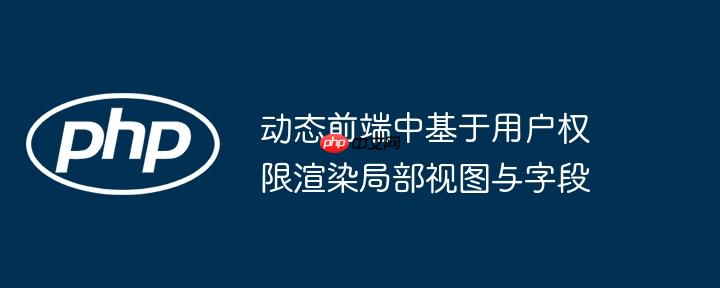
在现代Web应用开发中,尤其当采用RESTful API作为后端数据服务、JavaScript作为前端视图渲染引擎时,实现精细化的权限管理是一个常见且复杂的任务。传统基于角色的权限系统通常预定义了角色及其对应的操作权限。然而,在某些高度可配置的场景下,系统管理员可能需要动态地定义权限,例如,选择特定的数据库表、指定CRUD操作级别,甚至精确到哪些字段对哪些用户可见或可编辑。这种“运行时”定义的权限,对前端的UI渲染提出了更高的要求。
核心挑战在于,当后端API根据用户权限返回不同字段集时,前端JavaScript代码如何动态地适配这些变化,正确地渲染UI元素(如输入框、显示文本),并控制其可编辑性。例如,在一个图片管理界面,用户A可能只能看到图片的“名称”和“描述”字段并进行编辑,而用户B可能还能看到并编辑“位置”字段。更进一步,当用户点击“新增图片”时,前端需要根据当前用户的权限,动态生成包含正确字段的新行。由于JavaScript在客户端运行,它本身并不知道后端定义的复杂权限逻辑,因此需要一种机制来指导其进行视图渲染。
为了解决上述挑战,一种推荐的通用方法是引入一个专门的后端API端点,用于根据当前用户的权限,返回特定资源或操作的“字段结构”或“空数据对象模型”。前端不再是盲目地渲染所有可能的字段,而是先向这个API请求获取当前用户被授权查看和编辑的字段信息,然后根据这些信息动态构建或调整UI。
后端API端点(伪代码,以PHP/CakePHP为例):
立即学习“前端免费学习笔记(深入)”;
假设有一个ImagesController,我们需要为其添加一个方法来提供权限感知的空对象结构。
// In your ImagesController.php
namespace App\Controller;
use Cake\Controller\Controller;
use Cake\Http\Response; // For type hinting
class ImagesController extends Controller
{
// ... 其他方法 ...
/**
* 获取基于用户权限的空图片对象结构
* GET /api/images/emptyObject
*
* @return Response
*/
public function emptyObject(): Response
{
$this->request->allowMethod(['get']); // 限制为GET请求
// 1. 获取当前用户身份
$currentUser = $this->Authentication->getIdentity(); // CakePHP 4+ Authentication Plugin
// 2. 假设有一个权限服务来确定用户对'Image'资源的'create'操作允许哪些字段
// 这是核心业务逻辑,根据您的权限系统实现
$permissionService = $this->loadService('PermissionService'); // 加载自定义权限服务
// 假设getAllowedFieldsForResource返回一个数组,键为字段名,值为字段配置
// 例如:['name' => ['type' => 'text', 'label' => '名称', 'editable' => true], ...]
$allowedFieldsConfig = $permissionService->getAllowedFieldsForResource(
'Image', // 资源名称
'create', // 操作类型 (例如: 'create', 'edit', 'view')
$currentUser->getIdentifier() // 用户ID
);
$responseSchema = [];
foreach ($allowedFieldsConfig as $fieldName => $config) {
$responseSchema[$fieldName] = [
'type' => $config['type'] ?? 'text', // 默认文本类型
'label' => $config['label'] ?? ucfirst($fieldName), // 默认标签
'editable' => $config['editable'] ?? false, // 默认不可编辑
'value' => $config['defaultValue'] ?? null // 默认值
];
}
// 3. 将结果序列化为JSON返回
$this->set(compact('responseSchema'));
$this->viewBuilder()->setOption('serialize', ['responseSchema']);
return $this->response;
}
}前端JavaScript逻辑:
当用户点击“新增”按钮时,调用上述API并动态生成表单。
// HTML 结构示例: <div id="image-form-container"></div> <button id="add-new-image">新增图片</button>
document.getElementById('add-new-image').addEventListener('click', async () => {
const container = document.getElementById('image-form-container');
const resourceName = 'images'; // 对应后端资源的名称
try {
// 1. 请求后端API获取权限感知的字段结构
const response = await fetch(`/api/${resourceName}/emptyObject`);
if (!response.ok) {
throw new Error(`Error fetching schema: ${response.statusText}`);
}
const data = await response.json();
const schema = data.responseSchema; // 假设后端返回的JSON结构是 { "responseSchema": { ... } }
// 2. 创建一个新的表单行或区域
const newFormRow = document.createElement('div');
newFormRow.className = 'image-item-form';
// 3. 遍历 schema,动态生成表单元素
for (const fieldName in schema) {
if (Object.hasOwnProperty.call(schema, fieldName)) {
const fieldConfig = schema[fieldName];
// 创建标签
const label = document.createElement('label');
label.textContent = fieldConfig.label || fieldName;
label.setAttribute('for', `input-${fieldName}`);
newFormRow.appendChild(label);
// 创建输入框
let inputElement;
switch (fieldConfig.type) {
case 'textarea':
inputElement = document.createElement('textarea');
break;
// 可以根据需要添加更多类型,如 'select', 'checkbox' 等
case 'number':
inputElement = document.createElement('input');
inputElement.type = 'number';
break;
default:
inputElement = document.createElement('input');
inputElement.type = 'text';
break;
}
inputElement.id = `input-${fieldName}`;
inputElement.name = fieldName;
inputElement.value = fieldConfig.value !== null ? fieldConfig.value : '';
// 设置可编辑性
if (!fieldConfig.editable) {
inputElement.readOnly = true;
inputElement.style.backgroundColor = '#f0f0f0'; // 视觉上表示不可编辑
}
newFormRow.appendChild(inputElement);
newFormRow.appendChild(document.createElement('br')); // 简单换行
}
}
// 4. 将新生成的表单添加到容器中
container.appendChild(newFormRow);
} catch (error) {
console.error('Failed to add new image form:', error);
alert('无法加载新图片表单,请稍后再试。');
}
});对于显示现有数据,主数据API(例如 /api/images/{id})也应该在后端根据当前用户的“读取”权限过滤掉不允许查看的字段。前端接收到过滤后的数据后,可以直接遍历数据对象的属性来渲染。如果需要显示字段的可编辑状态,前端可以:
优点:
缺点与注意事项:
在RESTful API和JavaScript驱动的前端应用中,实现动态、字段级的权限管理是一个需要精心设计的任务。通过引入一个专门的后端API来提供权限感知的字段结构,前端能够动态地、安全地渲染UI,从而将复杂的权限逻辑从前端解耦。尽管这种方法可能引入额外的网络延迟,但通过合理的缓存和优化策略,其带来的灵活性、安全性和代码清晰度通常能弥补这一缺点。这种通用的架构模式适用于任何现代Web框架,包括CakePHP等,开发者只需在其控制器层和业务逻辑层实现相应的权限服务和API端点即可。
以上就是动态前端中基于用户权限渲染局部视图与字段的详细内容,更多请关注php中文网其它相关文章!

每个人都需要一台速度更快、更稳定的 PC。随着时间的推移,垃圾文件、旧注册表数据和不必要的后台进程会占用资源并降低性能。幸运的是,许多工具可以让 Windows 保持平稳运行。

Copyright 2014-2025 https://www.php.cn/ All Rights Reserved | php.cn | 湘ICP备2023035733号